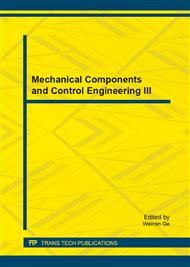[1]
Twenty-five Requirements to Prevent Serious Accidents in Electric Power Production. State Grid, September 28, (2000).
Google Scholar
[2]
The 18 Major Anti-accident Measures of State Grid. State Grid, June 14, (2005).
Google Scholar
[3]
Yonghua Yin, Jianbo Guo, Jianjun Zhao, Guangquan Bu: Preliminary Analysis of Large Scale Blackout in Interconnected North America Power Grid on August 14 and Lessons to be Drawn. Power System Technology, October, (2003).
Google Scholar
[4]
Meiyi Wang: Large Power System Technology. China Electric Power Press, May, (1991).
Google Scholar
[5]
Meiyi Wang: Analysis of Large Power System Accident and Technology Application. China Electric Power Press, September, (2008).
Google Scholar
[6]
Shengli Chen, Di Wu, Yueqin Sun, Wei Tang: Britain Power Market Development and Coordinated Management between Unit and Grid. Anhui Electric Power, December, (2006).
Google Scholar
[7]
Rui Ge, Yu Dong, Yuechun Lv: Analysis of Large Scale Blackout in UCTE Power Grid and Lessons to be Drawn to Power Grid Operation in China. Power System Technology, February, (2007).
Google Scholar
[8]
Weifang Lin, Huadong Sun, Yong Tang: Analysis on Causes of Blackout Occurred in Brazil Power Grid on Nov. 11, 2009 and Lessons Drawn From It. Automation of Electric Power Systems, April, (2010).
Google Scholar
[9]
Coordination of Relay Protection Settings for Power Equipment in Grids and for Power Grids as a whole Reviewed in US. International Electric Power, April, (2005).
Google Scholar
[10]
Technical Requirements for Interconnection to the BPA Transmission Grid, 2005 BPA.
Google Scholar
[11]
IEEE Guide for Abnormal Frequency Protection of Power Generating Plants, IEEE Standard C37-106-(2003).
Google Scholar
[12]
Sili Fang, Weimin Su: Analysis of Dynamic Performance Index Standards of Excitation System. Electric Equipment, July, (2004).
Google Scholar
[13]
Wenfeng Li, lei Gao, Huadong Sun: Performance Requirement of Excitation Control System of Large Thermal Power Centralized Transmission Unit. China Electric Power Research Institute, May, (2010).
Google Scholar
[14]
IEEE Recommended Practice for Excitation System Models for Power System Stability Studies, IEEE Std 421. 5 –(2005).
Google Scholar
[15]
Final Report on the August 14, 2003 Blackout in the United States and Canada: Causes and Recommendations, U.S. – Canada Power System Outage Task Force, April 5, (2004).
Google Scholar
[16]
IEEE Committee Report Performance of Generator Protection During Major System Disturbances, IEEE Transactions on Power Delivery. IEEE Transactions on Power Delivery, Vol19, Oct. (2004).
Google Scholar
[17]
NERC PRC-001-0 – System Protection Coordination, Adopted by NERC Board of Trustees, Feb 8, (2005).
Google Scholar
[18]
"NERC PRC-019-1 Coordination of Generator Voltage Controls with Unit Capabilities and Protection, Pending NERC Review and Approval.
Google Scholar
[19]
IEEE Std C37. 106™{TTP}8482 -2003, IEEE Guide for Abnormal Frequency Protection for Power Generating Plants.
Google Scholar
[20]
Coordination of Generator Protection with Generator Excitation Control and Generator Capability, Working Group J-5 of the Rotating Machinery Subcommittee, Power System Relay Committee, (2007).
DOI: 10.1109/pes.2007.386034
Google Scholar


